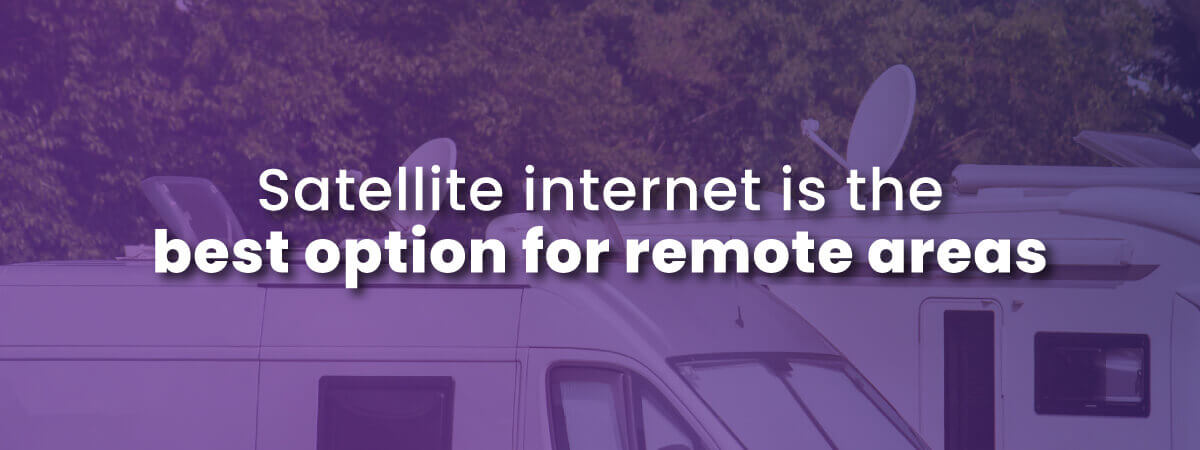Is Satellite Internet Right For You? Find Out Here
Table of Contents
Having a fast, reliable home Internet connection is essential in 2024. Your Internet access is key to online opportunities – including remote work, education and even virtual doctor visits.
Unfortunately, many rural or less-populated areas lack options for Internet service. Laying cable or fiber lines is expensive and time-consuming, and our wired infrastructure is still struggling to catch up to demand.
But there’s good news. Satellite Internet is available to almost every home in the USA. With satellite, you can have high-speed Internet at home, even if there’s no cable or fiber in your town.
Is satellite Internet right for you? The answer will depend on your current home Internet options at your address. You’ll also need to consider what you usually do on the Internet, and how much Internet speed you need. But there’s a good chance that satellite service can supply all your most important needs for an Internet connection.
In this article, you’ll find everything you need to understand satellite Internet service, its pros and cons, and whether satellite is right for you at your current home.
How Satellite Internet Works
Satellite Internet service does not require any wiring to reach your home. So, no matter how far you are from an urban center, you can still get service from a satellite Internet provider. All you will need is an unobstructed view of the sky. People can get satellite Internet even on boats, desert islands, or mountain peaks.
Your satellite Internet signal will travel as radio waves from a big ground station called a Gateway Earth Station (GES). The signal goes up thousands of miles into space until it reaches a high-tech satellite. That satellite will “catch” that signal of radio waves and “throw” it back down to Earth again, all the way to the satellite dish at your home.
This space journey is truly a stunning feat of technology, even though we sometimes take it for granted. In less than one second, a signal travels tens of thousands of miles from earth to space and back, four times, bringing you all kinds of complicated data and images. We’ve come a long way from tin cans on a string!
Your satellite dish (a type of antenna) catches that radio wave signal. The dish turns the radio waves into a data signal and sends it inside your house via coaxial cable to your modem/router. From your modem/router, an ethernet cable brings the data to your computer and other digital devices. Or, you can set up a home W-Fi network to send your data to your devices by wireless.
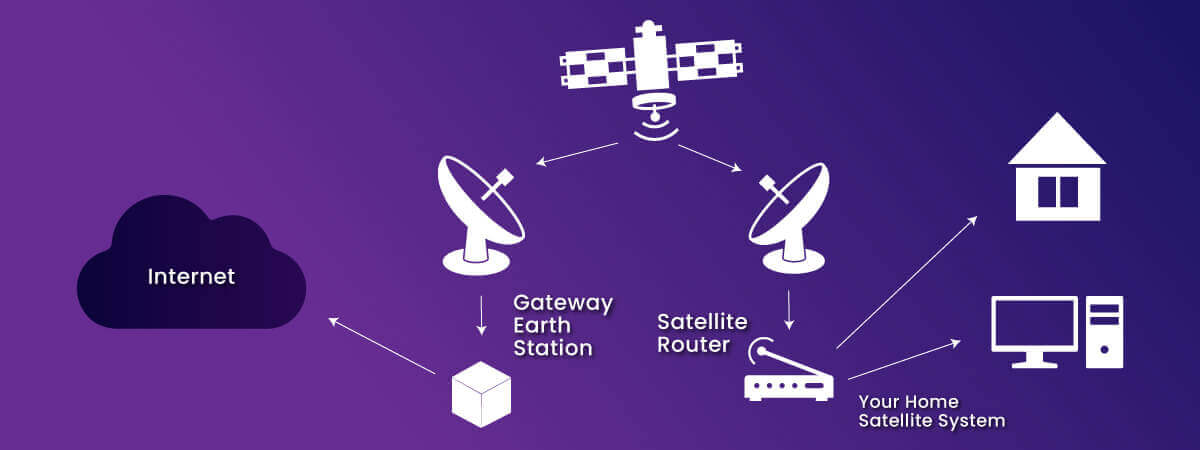
How did satellite Internet get so advanced?
Here’s a mini explanation of where satellite technology started and where it’s headed. Read on to understand why satellite Internet is much better than it was ten years ago, and why it will be even better in a year than it is today.
Satellite technology is pretty young. It only started in 1957 with the launch of Russia’s first satellite, Sputnik. Bell Labs launched the first commercial communications satellite in 1962.
Then, in 1963, satellite technology hit a major milestone when the first geostationary satellite went into orbit. That satellite was produced by the Hughes Aircraft Co, later Hughes Network Systems. One of the few major satellite Internet providers in the USA is now called Viasat. Coincidence? We think not!
Today’s major satellite provider called Viasat is a kind of corporate grandchild of that historic company known as Hughes Aircraft Co. And even better, Viasat Aircraft Co. was originally founded by legendary aviator and eccentric tycoon Howard Hughes. Is that cool or what?
In the early 2000s, satellite companies began to develop faster satellite speeds known as High-Throughput Satellites (HTS).
New satellite Internet technologies in 2024
Satellite Internet is constantly advancing and improving.
That’s the skinny on how we got to these tech marvels that satellite Internet can perform today. More and more satellites are hitting the skies, including High Earth Orbit (HEO) satellites, Medium Earth Orbit (MEO) satellites, and Low Earth Orbit (LEO) satellites. You will soon have more powerful satellite Internet options than anyone could have imagined even ten years ago.
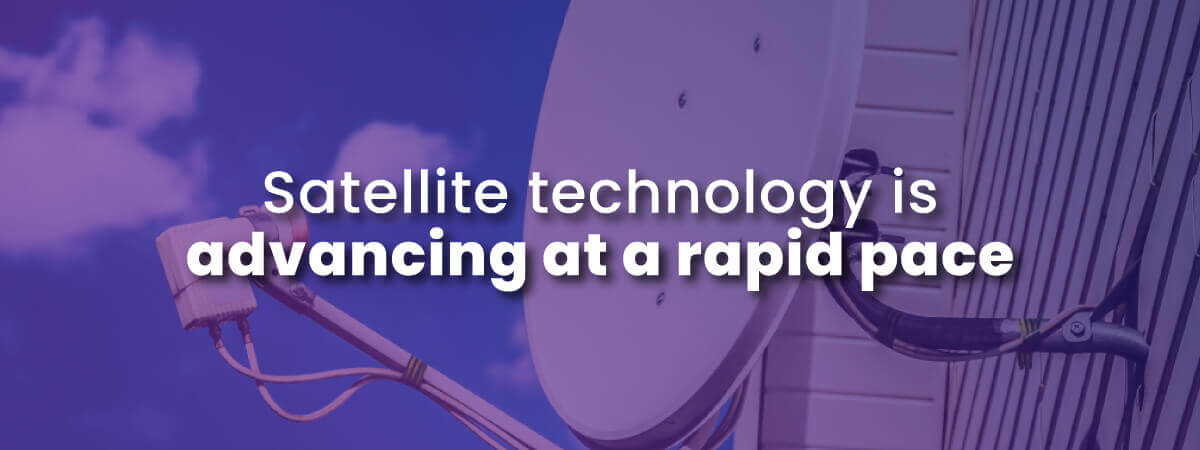
Let’s take a quick look at the general pros and cons of satellite Internet service. This quick overview will show you what to consider to see if satellite Internet is right for you.
Pros of Satellite Internet
Global coverage
Satellite Internet can reach places no other kind of Internet connection can reach. Coverage is the number one strength of satellite service. That’s why rural customers have trusted satellite Internet for years.
High-speed Internet in rural or remote areas
Advances in technology in the past six years mean that satellite Internet can often provide faster speeds to customers than older DSL connections. And satellite is certainly significantly faster than dial-up Internet, which is sometimes the only alternative in a remote area.
Satellite Internet is more secure than public Wi-Fi
Sometimes, you may be tempted to make do with public Wi-Fi hotspots if you’re in an area without a lot of Internet options. But to use your home Internet for banking, taxes, or job applications, you will want a secure Internet connection. Satellite Internet will provide a much more secure connection than public Wi-Fi.
Satellite Internet is not affected by cable damage
Weather and construction accidents can cause outages for wired Internet services such as cable and fiber. But as a satellite customer, you won’t have to worry about losing your Internet for days after trees fall on lines.
Satellite Internet offers fast enough speeds for most Internet users
Advances in satellite connection speeds mean that the vast majority of Internet activities will be easily supported on satellite. Checking email, browsing the web, filling out forms, or scanning through social media platforms will be smooth.

Cons of Satellite Internet
Data allowances
Satellite Internet providers are working under different constraints than other ISPs. A satellite has a certain amount of bandwidth, and lots of customers need to share that bandwidth. To ensure that every customer gets a fair share, satellite providers use data allowances. So, your plan may allow you 15 GB, 50 GB, or 150 GB per month. Once you reach that data limit, your Internet will slow down dramatically, so you can’t do much except perhaps check email. These data allowances are often called soft data caps. They are soft because you don’t lose service when you go over your limit. You also don’t get charged data overage fees, the way you might on a cell phone plan.
In addition, some providers such as Viasat allow you to purchase extra data tokens at reasonable rates if you need more at the end of the month. But the reality is that you will get less data usage on satellite than you would on wired Internet services. High-data activities such as Ultra HD streaming or online gaming are not recommended because they consume so much data quickly.
Higher latency
Latency is a delay in a signal caused when data has to travel a very long way. Because satellites can be as far as 22,000 miles out in orbit, latency affects satellite Internet more than other types of Internet technology. However, overall, the delay is miniscule: about half a second for that entire space odyssey. For most Internet activities, you won’t notice latency. The tasks for which the lag might affect your performance are online gaming, videoconferencing, and streaming.
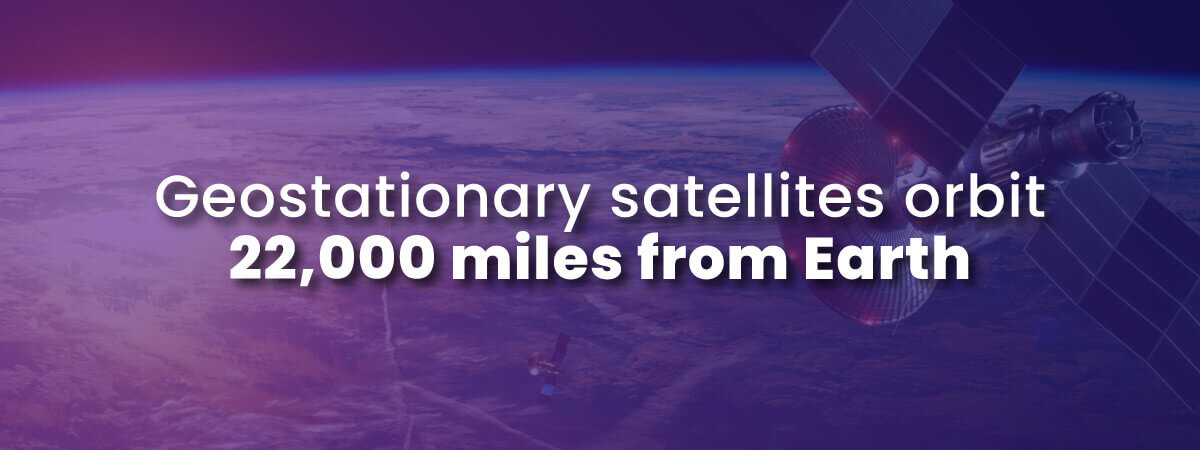
Signal interference from obstacles
Trees, buildings, or other obstacles can block the satellite signal, which can cause slower speeds or a service interruption. However, with correct installation and maintenance from your satellite service technician, these kinds of obstacles would be rare.
“Rain fade” related to weather
Heavy storms can also interfere with a satellite signal and cause a temporary lost connection. Satellite industry experts often call this “rain fade.” However, when the rain lightens up, your service will return to its customary strength.
| PROS – SATELLITE INTERNET | CONS – SATELLITE INTERNET |
| Global coverage | Latency |
| More secure than public Wi-Fi | Data caps (soft) |
| High-speed Internet supports most tasks | Signal interference |
| Not affected by downed trees/construction damage | Rain fade from weather |
5 Factors to Determine if Satellite Internet is Right for You
Your Preferred Internet Activities and Data Usage
By now, you know that satellite Internet service can provide you with high-speed Internet that supports most Internet activities. However, the speed of satellite data will not be as fast as the speeds of some other types of Internet connection such as cable and fiber. In addition, satellite data allowances mean that you will have to be careful about certain types of high-data activities if you use a satellite Internet plan.
The most data-intensive activities that most people do on the Internet are real-time, online gaming and HD video streaming. If you are an avid online player of FPS games, for example, understand that satellite is not recommended for those games. But turn-taking games that don’t depend on split-second reactions can work just fine on a satellite connection.
Satellite Internet will support streaming, but satellite providers will often have a way for you to stream video that is not high-definition (HD).
Your Geographic Location
Here are two main questions to ask yourself about your location that will tell you whether satellite is a natural choice for you.
- Do you live in a rural area or another area that does not have cable or fiber wired broadband. If the answer is yes, and you don’t have a fast, wired Internet option, then satellite will be the obvious choice. One gray area is the availability of DSL. If the only wired connection in your area is DSL, you need to find out what the actual speed of that DSL connection is. Newer DSL (sometimes called IPBB) may be able to compete with satellite speeds. Older DSL can be as slow as 5 Mbps download. If older DSL is your only wired choice, you’re probably better off with a satellite Internet provider.
- Do you travel frequently, as many RV owners do? You may need a portable Internet solution that can work both in cities and in very remote areas. If so, satellite Internet service would be your best bet.
Costs and Contracts for Satellite Internet Service and Equipment
Satellite Internet does tend to be more expensive than other types of Internet service. For many customers, it’s worth it because of the reliability and coverage of the satellite Internet connection.
Prices
Satellite providers price their Internet plans according to your data allowance. So, for example, a first-tier data plan for 30-40 GB of data per month might cost $50-70/month. A higher-tier plan for 100 to 150 GB might cost $100 to $175/ month. Introductory offers often allow customers to realize big savings in the first year of their contract. If you go over your data limit, extra data tokens from Viasat are priced at $9 for 3 GB and $30 for 10 GB.
Contracts
The two major satellite providers, Viasat and HughesNet, both require 24-month contracts. Early cancellation will trigger early cancellation fees. So, be aware and plan accordingly. Newcomer provider Starlink does not require a contract, but service is only available in some parts of the country.
Equipment Costs
Some providers such as Viasat and HughesNet will allow you to rent your equipment for a flat fee per month ($13-20).
Viasat will allow you to buy your own equipment at any time, which may be pricey to begin with ($250-300) but will save you money if you stay on the Viasat plan for more than two years.
Viasat will allow you to pay an upfront rental fee that is cheaper than the monthly rental fee, but you still do not own the equipment.
Starlink requires the purchase of equipment upfront that can cost from $599-2599. They offer a full money-back guarantee on the equipment return if you cancel your plan in the first 30 days.
Installation and Setup
Viasat and Hughesnet often offer free installation with their contracts. Starlink offers a self-install.
Technical Support and Customer Service
Both Viasat and Hughesnet have 24/7 customer service numbers. Starlink has had some issues with poor customer service.
Many times, your neighbors will be a reliable guide to whether you will get prompt and trustworthy customer service from a wired ISP in your area. Now that many ISPs have store locations, you’ll want to know how long it usually takes to get store service vs. phone service.
Live chat can also be extremely helpful when you have a problem and you need some support from your ISP. Both Viasat and HughesNet have live chat support. A number of wired providers have it as well.
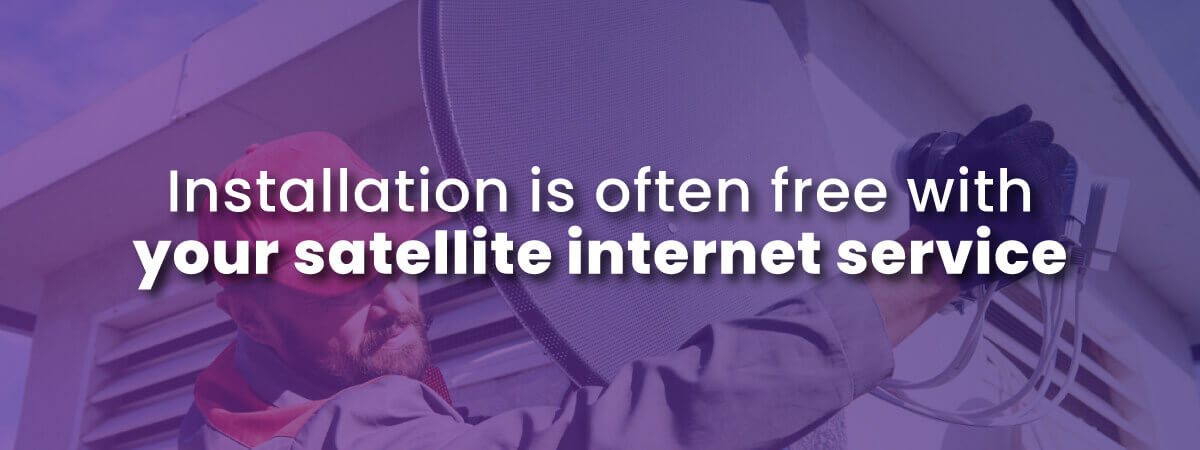
Alternatives to Satellite Internet
Cable Internet
Cable Internet is fast, reliable, and low-latency. The chief disadvantage of cable Internet is that availability is limited, so many homes in the USA don’t have the option of cable.
Fiber Internet
Like cable, fiber-optic Internet is extremely fast and reliable. Unlike any other Internet technology, fiber Internet offers symmetrical upload and download speeds. Unfortunately, fiber has very limited coverage and many households will not have a choice of fiber service.
Cellular and Wireless Internet
Cellular and wireless Internet travel by cell towers and radio signals. Like satellite Internet, wireless tends to have data allowances and to be slower than wired connections. Wireless Internet such as T-Mobile and Verizon also tends to be more common in urban centers and populated areas. In more rural areas, coverage from wireless Internet providers is much more limited than coverage from satellite Internet providers.
DSL
DSL is the weakest of the wired alternatives to satellite, unless you can get the newer DSL sometimes called IPBB. WIth DSL, it is crucial to know exactly what the real speed of your service will be. Check with neighbors near you who have the same DSL service you are considering. DSL service will often make claims such as “up to 100 Mbps” when the actual speed could be as low as 5 Mbps. For more, see our guide to Satellite vs. DSL.
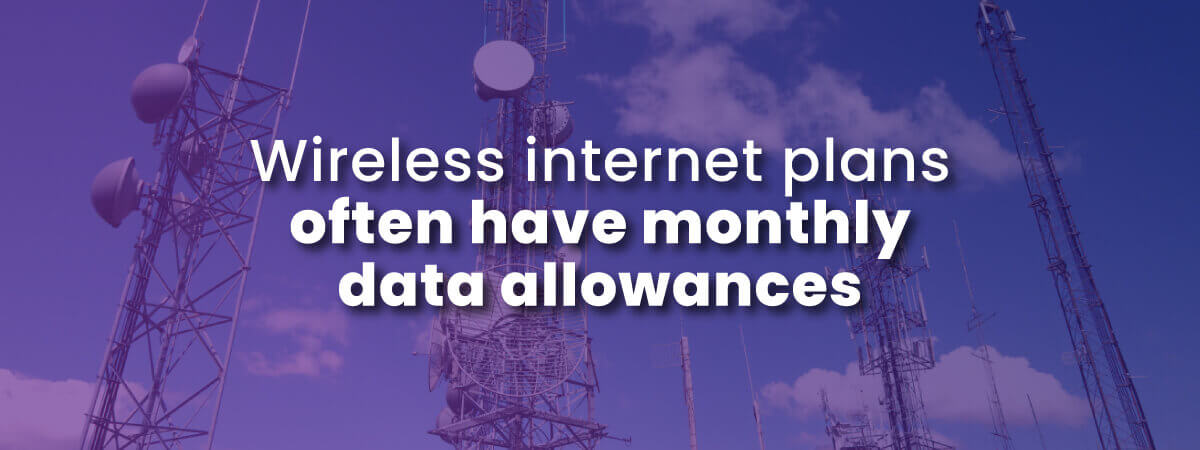
FAQs: Is Satellite Internet Right For You?
What are the best Internet options for rural areas?
Many rural areas do not have strong wired infrastructure, but they do have satellite Internet service. For that reason, satellite Internet often comes out on top as a choice for customers who live in areas that don’t have cable or fiber. For more, see our Ultimate Guide to Internet in Rural Areas.
Is satellite Internet good for gaming?
Satellite Internet is not usually recommended for real-time, split-second reaction gaming such as Call of Duty or Halo. Turn-taking games and casino games can work just fine via a satellite Internet connection.
What are the fastest satellite Internet providers?
Viasat may offer speeds as high as 150 Mbps, but speeds vary, so you also might get 12 Mbps depending on your geographic location. Starlink claims to offer a lower-latency connection up to 100 or 200 Mbps with its LEO satellites, but Starlink is not available in much of the USA.
What is the contract length for satellite Internet?
Viasat and HughesNet require 24-month contracts. Starlink does not require a contract. Viasat will allow customers to pay an upfront fee for a no-contract plan, but the fee is $300, which may be more than an eventual cancellation fee depending on when the customer cancels.
What is an early cancellation fee for satellite Internet?
Both Viasat and HughesNet charge similar cancellation fees for early termination of a contract. The fees begin at about $350-400 and drop by about $15/month for every month the customer remains on the contract. So, for example, if you canceled your contract after 10 months, you might owe about $200-250 in early cancellation fees. If you canceled your service after 20 months, you would own only $50-100 in early cancellation fees.
What is the best Internet option for RV and boat owners?
RV owners who often travel to rugged and remote areas will do best with a portable satellite Internet plan. Only satellite will provide coverage in the remotest areas where cellular and wireless are not available. Similarly, boat owners often won’t get coverage without satellite Internet.
